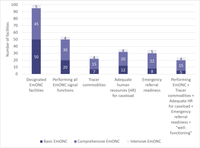Indicator 1b: Progress toward interim goal for scaling up EmONC availability
This indicator is the proportion of EmONC facilities designated by the ministry of health that are performing all EmONC signal functions.
Numerator:No. facilities performing all EmONC signal functions
Denominator:No. designated EmONC facilities
× 100Purpose
To save women with obstetric complications and newborns born small and sick, facilities that are designated as EmONC must perform all of the EmONC signal functions.
Data collection and calculation
The numerator for this indicator is the number of facilities that perform all of the EmONC signal functions for their designated level.
The denominator is the number of facilities that are designated by the ministry of health to become EmONC facilities within a programme cycle (i.e., number of designated Basic EmONC facilities, designated Comprehensive EmONC facilities and designated Intensive EmONC facilities). Description of the process for facilities to be designated for implementation of EmONC strengthening interventions can be found in ‘How to use the EmONC Framework’.
To calculate this indicator, the total number of facilities that perform all EmONC signal functions is divided by the number of designated EmONC facilities. The indicator is typically expressed as a percentage.
A similar exercise will determine what percentage of designated Basic, Comprehensive and Intensive EmONC facilities are performing EmONC at their intended level.
Analysis and interpretation
The benchmark for this indicator is 100% of designated EmONC facilities are performing EmONC at their intended level.
Disaggregation of this indicator by characteristics such as sub-national area, managing authority, type of facility, and rural/urban location can reveal patterns and flag where further focus is needed.
The EmONC classification of a facility can vary from one quarter to the next for a variety of reasons. Key personnel can be transferred; stock outs or supply chain failures can occur; or caseloads can drop because of a disease outbreak. Yet the goal of monitoring the availability of EmONC on a quarterly basis is to eventually sustain the performance of well-functioning EmONC facilities so that all women with complications and babies born small and sick can receive prompt care any time it is needed.
It is particularly useful to analyze signal function performance alongside the “Infrastructure,” “Equipment, Drugs and Supplies,” “Health Workforce Adequate for Caseload,” and “Emergency referral readiness” indicators. They can be shown together as a cascade, as below. (For more information, see ’Supplemental studies’ below.)
Figure 1: Summary of EmONC functionality; hypothetical example showing the number of facilities that are performing EmONC under adequate conditions

Supplemental studies
Analyzing and presenting the performance of EmONC with the elements of readiness (presenting the ‘EmONC Functionality Cascade’)
To save women with obstetric complications and newborns born small and sick, the health system must have facilities that are equipped, staffed and ready to perform EmONC at all times. By analyzing and presenting the performance of EmONC signal functions along with indicators measuring the key elements of readiness (i.e., tracer commodities, health workforce adequate for caseload and emergency referral readiness) it is possible to identify gaps and bottlenecks in functionality of the EmONC system. This type of analysis can supplement the process of interpreting Indicator 1b results and could be produced on a routine basis (e.g., quarterly, semi-annually, annually) to monitor the functionality of the EmONC system. For further instructions, please see EmONC functionality cascade.
Useful links
- Brun M, Monet, JP, Schaaf, M, Agbigbi, Y, Lysias, J, Moreira, I, Ray, N. Implementation Manual for Developing a National Network of Maternity Units. 2020. UNFPA, University of Geneva.